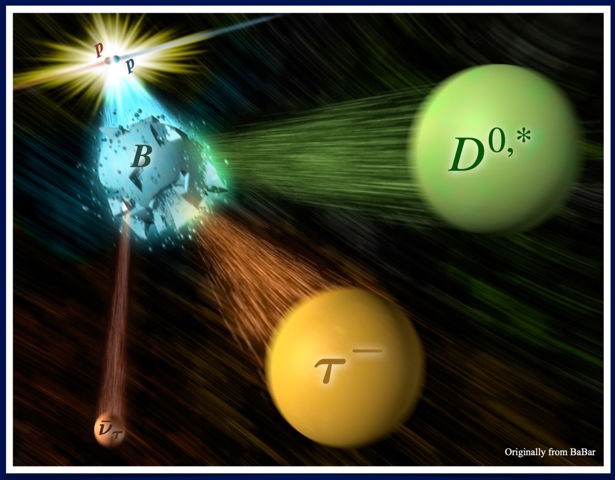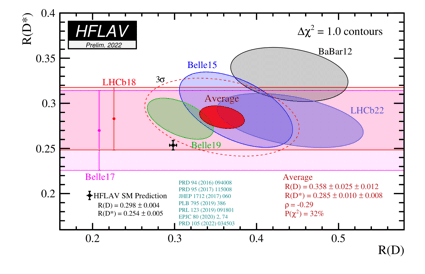Physicists in general, and high energy physicists in particular, like to "break" things. It can be useful to prove again that a well established theory is true, especially if you are probing a yet-untested prediction of the venerable theory. But proving that the theory is wrong--or at least not completely true--that is where the fun is. This is why a series of measurements of b hadron decays that seemingly break the Standard Model (SM) of particle physics is garnering so much excitement.
You see, the SM is the most well established theory of them all, the only one with predictions corroborated to the 11th digit (see the anomalous magnetic moment of the electron). It was fully fleshed out in the 70's, and since then it has racked up success after success. Its crowning achievement came in 2012 when the long-predicted Higgs boson was finally confirmed to be alive and well. Despite this resiliency, the SM is not the end of it all. It can't explain why the mass of the Higgs is so low, what the nature of dark matter is, or why there is so much more matter than antimatter in the universe. Finding answers to these questions will thus require breaking, or extending, the SM.
Enter Lepton Flavor Universality (LFU) violation. LFU is a fundamental assumption within the SM involving the three lepton flavors: electron, muon, and tau. All SM interactions other than the Higgs are assumed to be flavor universal, and this has been shown to be true in numerous measurements. Since 2012, however, an intriguing pattern has emerged in decays of b hadrons (particles with a b quark inside) to final states with a c quark, a tau lepton τ, and a neutrino ν. When results involving a tau lepton and a neutrino are compared to decays involving a muon or an electron and a neutrino, they tend to be higher than we'd expect from SM calculations. This is shown in the nearby figure by all the measurements keeping their distance from the theoretical predictions in blue. Measurements that measured the two LFU quantities RD and RD* are shown as
 Artistic representation of a proton-proton collision resulting in a B meson that subsequently decays to a charmed D0 or D* meson, a tau lepton, as well as a smaller antineutrino. Credit: Greg Stewart, SLAC National Accelerator Laboratory/BaBar and Manuel Franco Sevilla.
Artistic representation of a proton-proton collision resulting in a B meson that subsequently decays to a charmed D0 or D* meson, a tau lepton, as well as a smaller antineutrino. Credit: Greg Stewart, SLAC National Accelerator Laboratory/BaBar and Manuel Franco Sevilla.ellipses while measurements of RD* alone are shown as markers with uncertainties.
None of these results on their own rises to what is typically known as an "observation" (5σ statistical significance), and it could very well go away. For instance, a similar pattern that had appeared when comparing decays involving a kaon and two muons to decays with a pair of electrons
was recently shown to be an artifact of an underestimated background. But the consistency among results that share the same b→ cτν underlying process is very suggestive. Multiple explanations have been proposed that would explain all of these with physics beyond the SM (BSM). A particularly neat solution postulates a new kind of exotic particle that interacts with both leptons and quarks: a vector leptoquark.
In an article published last year in
Review of Modern Physics (
"Semitauonic b-hadron decays: A lepton flavor universality laboratory"), my co-authors and I comprehensively described these results, delved into the main sources of uncertainty, and mapped out the future measurements. Spoiler alert: while we do not know whether BSM physics will be discovered, we are rather confident that we will know whether these results are due to BSM physics or not within 5-10 years.
And the first of these new results was
just submitted to Physical Review Letters Professor Hassan Jawahery and Dr. Phoebe Hamilton, together with Dr. Greg Ciezarek from CERN, measured for the first time RD and RD* simultaneously at LHCb. The uncertainties are still large, so it is hard to say whether the discrepancy will be proven true. But this result sets the stage for another mea
 The results reflect analysis of two years of data by Phoebe Hamilton and Hassan Jawahery and their CERN collaborator, Greg Ciezarek.
The results reflect analysis of two years of data by Phoebe Hamilton and Hassan Jawahery and their CERN collaborator, Greg Ciezarek.surement based on the same techniques that uses a data sample more than 6 times larger. This work, carried out by the all-UMD team Professor Manuel Franco Sevilla, Dr. Hamilton, Dr. Christos Hadjivasiliou, Yipeng Sun, and Alex Fernez, is now fairly advanced. So stay tuned, there's potential for SM-breaking ahead!
--Manuel Franco Sevilla
 Artistic representation of a proton-proton collision resulting in a B meson that subsequently decays to a charmed D0 or D* meson, a tau lepton, as well as a smaller antineutrino. Credit: Greg Stewart, SLAC National Accelerator Laboratory/BaBar and Manuel Franco Sevilla.ellipses while measurements of RD* alone are shown as markers with uncertainties.
Artistic representation of a proton-proton collision resulting in a B meson that subsequently decays to a charmed D0 or D* meson, a tau lepton, as well as a smaller antineutrino. Credit: Greg Stewart, SLAC National Accelerator Laboratory/BaBar and Manuel Franco Sevilla.ellipses while measurements of RD* alone are shown as markers with uncertainties. The results reflect analysis of two years of data by Phoebe Hamilton and Hassan Jawahery and their CERN collaborator, Greg Ciezarek.surement based on the same techniques that uses a data sample more than 6 times larger. This work, carried out by the all-UMD team Professor Manuel Franco Sevilla, Dr. Hamilton, Dr. Christos Hadjivasiliou, Yipeng Sun, and Alex Fernez, is now fairly advanced. So stay tuned, there's potential for SM-breaking ahead!
The results reflect analysis of two years of data by Phoebe Hamilton and Hassan Jawahery and their CERN collaborator, Greg Ciezarek.surement based on the same techniques that uses a data sample more than 6 times larger. This work, carried out by the all-UMD team Professor Manuel Franco Sevilla, Dr. Hamilton, Dr. Christos Hadjivasiliou, Yipeng Sun, and Alex Fernez, is now fairly advanced. So stay tuned, there's potential for SM-breaking ahead!